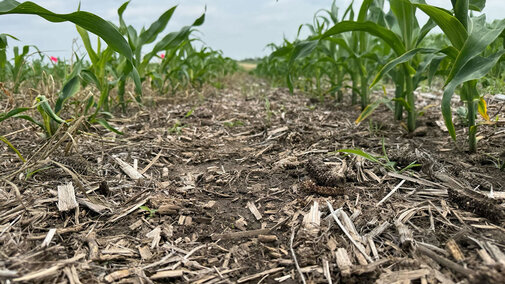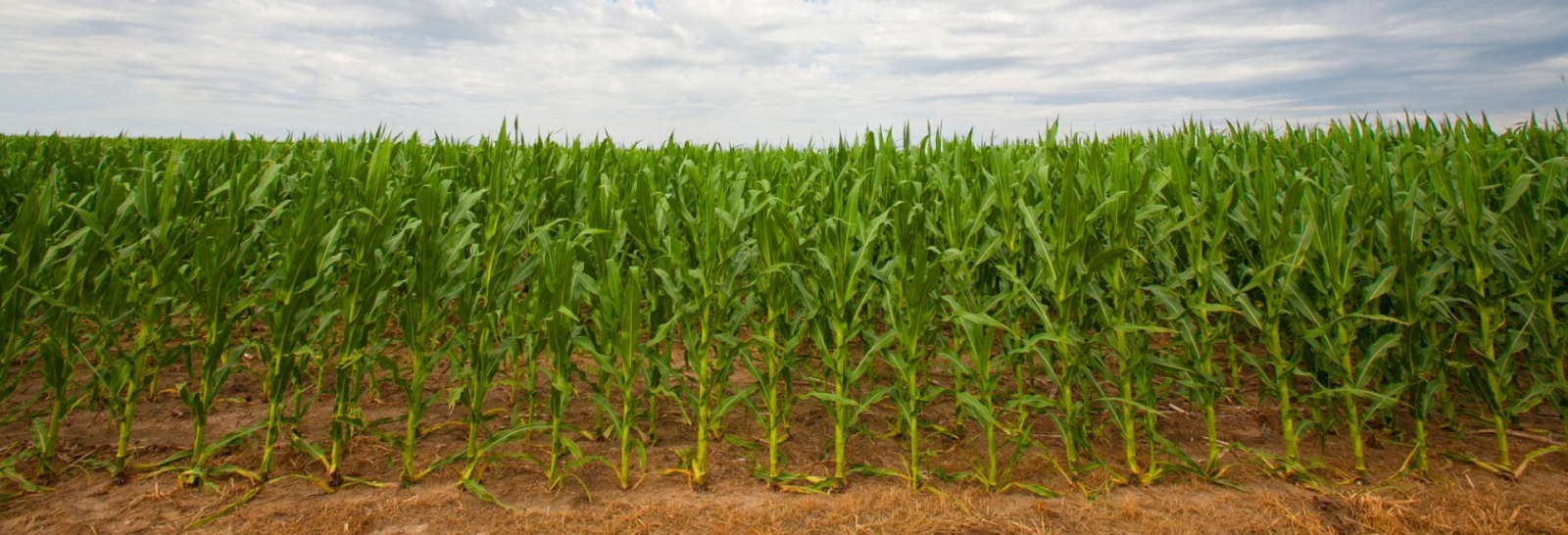What’s Happening?
Some farmers and crop consultants in southern, central and eastern Nebraska are seeing young corn plants with wilted or dead leaves in the whorl (Figure 1). If you cut these plants open, you may find a small white maggot — likely the wheat stem maggot. The larvae can be difficult to find. Recovery rates of larvae from damaged plants were 11% to 80% depending on the field, according to a past survey.
This problem was first documented in Nebraska in 2017, although sporadic issues have occurred before that. Issues were isolated to fields where corn followed a green cover crop like rye or wheat. The problem only occurs in areas where a rye or wheat cover crop was planted, and damage can range from just a few plants to more than 50%. In some cases, growers have reported yield losses of up to 30 bushels per acre.
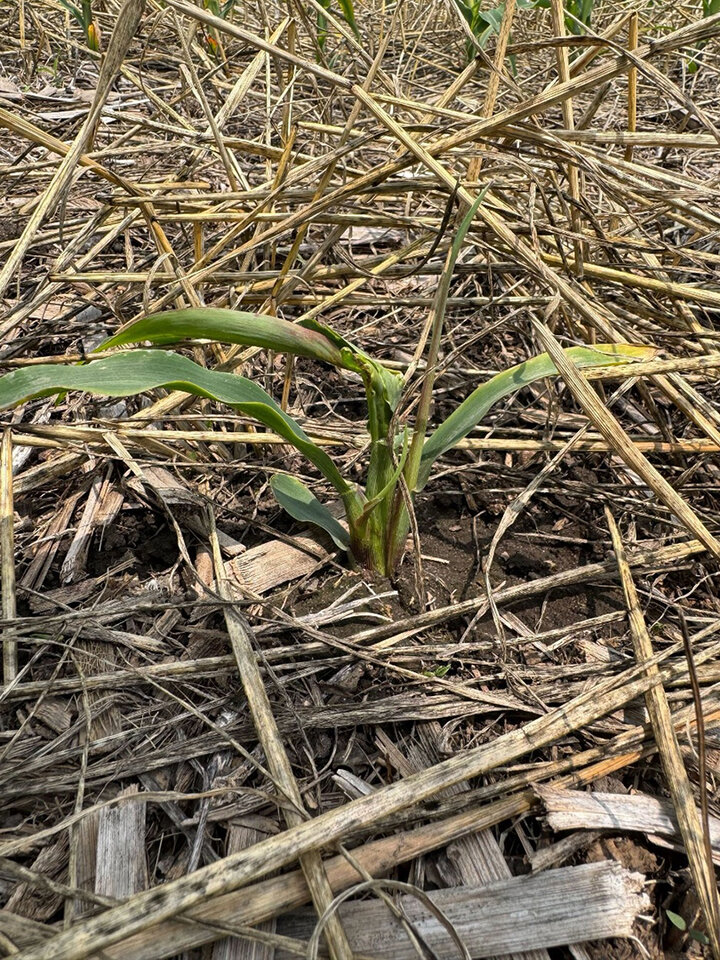
Learning from This Year’s Problem
Aaron Nygren, extension educator at the Eastern Nebraska Research Extension and Education Center (ENREEC), has been planting corn into green rye for years. But this year, for reasons we don’t fully understand, he’s seeing quite a bit of wheat stem maggot damage (Figure 2), similar to what some farmers are now experiencing across the state.
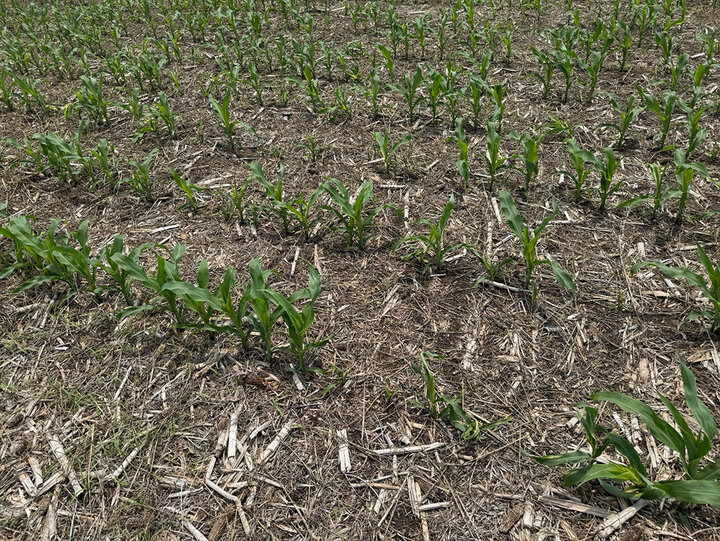
The silver lining in the situation at ENREEC is that this gives us a chance to monitor different plant injury levels from wheat stem maggot throughout the season and take yield data on those individual plants at harvest. This information will help us understand how much damage corn plants can recover from.
Observations of wheat stem maggot have been reported by crop adjusters, farmers and extension educators across the state. Below are some of the observations from extension educators:
- Polk County — TJ Prochaska: Infestation rates were below 5% and again were associated with cornfields where rye had been utilized as a cover crop.
- Dawson, Buffalo, Hall — Talon Mues: Infestation rates up to 50% in a single field where a rye cover crop was terminated three weeks after planting.
- Adams, Kearney, Franklin, Webster — Ron Seymour: Highest infestation was around 36%, with most fields that were green-planted closer to 11% infestation.
- York, Seward and Fillmore — Jenny Brhel: Infestation between 5% to 50%, all where corn was planted green into rye.
Some of these infestation rates may be concerning, but it’s important to note that an infested plant has the potential to yield if it has tillered or the main stem isn’t too badly damaged.
Will Larvae Move Between Corn Plants?
Some growers are worried that the maggots might move between corn plants, but this is very unlikely. Once the maggot enters a plant, it usually stays unless that plant dies. Most corn plants with damage survive and often produce tillers, which can still contribute to yield.
The lack of movement between plants is also evident by how closely linked the rye cover crop is to corn damage. Move even just 30 inches away and there are almost no infested plants (Figure 3).
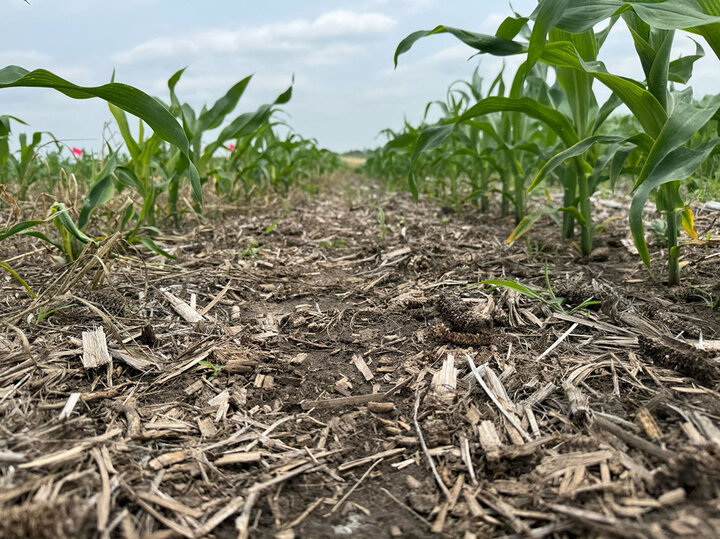
Management Recommendations
1. Insecticide + Herbicide at Cover Crop Termination?
We do not recommend tank mixing insecticide with herbicide at cover crop termination for two key reasons:
- You might kill off beneficial insects in the cover crop without knowing whether pests are present.
- The insecticide likely won’t last long enough to kill wheat stem maggot larvae as they move into corn.
2. Scout Before Termination
Inspect your cover crop for adult wheat stem maggots or larvae (Figure 4) before termination. If pest numbers are high, consider terminating the cover crop at least 14 days before planting corn. Currently, no research has been conducted to evaluate strategies to reduce wheat stem maggot infestations when planting corn into a green wheat or rye cover crop. The sporadic and unpredictable nature of this pest makes it challenging to design studies that test different termination timings or insecticide options.

3. If Early Termination Isn’t Possible
If you’re unable to terminate early and find heavy maggot pressure, a follow-up insecticide application 11 days after glyphosate may help if corn has emerged. This isn’t guaranteed to work but is based on best practices for similar pests like common stalk borer.
4. Thinking About Replanting?
Some growers are wondering whether to replant corn in heavily infested areas. Jenny Brhel, extension educator in York County, sees this issue on a few fields annually but hasn’t yet recommended replanting in general. It’s tough to hear that with how bad some of those fields look. Here are some thoughts for those who are considering a replant.
- If damaged plants are putting out tillers, they may still yield well. In the past, we’ve seen tillers put on an ear instead of a typical tiller-ear. We would recommend flagging some of these plants in your field(s) and watching development to gain more input into what producers are seeing as well.
- Take a stand count of “normal plants” in 1/1000th of an acre. Then take a stand count, including plants that have produced a tiller and plants where the main stem is still intact in spite of being impacted by the maggot. It really takes over 50% of the stand to be lost to justify replanting.
- If plants aren’t tillering or the main stem is buggy whipped tightly, and a large part of the stand is affected, replanting may make sense. We’ve mostly only replanted spotty areas of fields when the small grain cover crop wasn’t properly terminated and impacted corn plants in an area more.
- The tradeoffs with replanting include the reality of today’s date with potential yield loss compared the original stand, finding seed in a relative maturity that will make it to black layer before average fall frost for the area, and the cost/time for terminating the current crop and planting a new one.
5. Insecticide Applications
Some may wonder whether an insecticide application can still be effective once maggots have entered the whorl in corn. We do not recommend insecticide application at this point for several reasons:
- First, most of the damage from the maggots has likely already occurred, making an insecticide treatment unlikely to provide an economic return.
- Second, once wheat stem maggots complete development and emerge as adults, they do not reinfest corn.
- Third, there is no evidence that maggots will move between plants if their current host remains viable.
- Lastly, using an insecticide can kill natural enemies and lead to secondary pest issues.
Final Thoughts
Producers are choosing to plant corn green into a small grain such as wheat, rye and barley to fulfill a number of goals. These can include: erosion control, weed and pest management, improving water infiltration, and other soil health goals. While it’s disheartening to see one’s stand impacted by these wheat stem maggots, we encourage producers incorporating cover crops into their cropping systems to continue working towards your goals while being mindful of pests such as the wheat stem maggot. We don’t see wheat stem maggot as a problem pest every year, and we’re working to better understand when it’s most likely to appear and how best to manage it.
